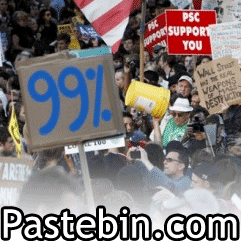 NEWS
NEWS
 NEWS
NEWS
 NEWS
NEWS
![]() The previous decade showed us how the Internet and social media change the face of protests. In fact, a leaderless collective of interested parties emerged from forums calling themselves Anonymous to form a surprisingly large mass protest against Scientology. We’ve seen social media provide the foundation for citizen journalists to document the going’s on of protests in Egypt and follow rioting and police response during the London riots. Blogs, Facebook, and Twitter all lend themselves to disseminating this sort of information and they’re used as such but it seems like the perfect-storm for sharing documents has fallen onto a different service.
The previous decade showed us how the Internet and social media change the face of protests. In fact, a leaderless collective of interested parties emerged from forums calling themselves Anonymous to form a surprisingly large mass protest against Scientology. We’ve seen social media provide the foundation for citizen journalists to document the going’s on of protests in Egypt and follow rioting and police response during the London riots. Blogs, Facebook, and Twitter all lend themselves to disseminating this sort of information and they’re used as such but it seems like the perfect-storm for sharing documents has fallen onto a different service.
The New York Times is running an article about how the site Pastebin.com became a central part of the communication that organized the thoughts of Occupy Wall Street protestors during its infancy.
Pastebin began as a site directed towards allowing developers to share snippets of programming code with one another. However, as a result of its unstructured nature (accepting pretty much anything that could be represented in plain text) the site lends itself for a multitude of uses. The second part of the site—anonymous logins permitted, no registration, and the ability to just drop something into the bin—attracted the attention of the hacker group LulzSec.
During their reign of mayhem, LulzSec used Pastebin repeatedly to make announcements and impromptu anonymous press releases about their exploits. The usefulness seemed obvious: essentially an Internet corkboard for people to tack up messages and then point to them. LulzSec combined the anonymous nature of Pastebin with the reputation-based, microblogging function of Twitter to generate notice and notoriety for their press releases.
As a result, once LulzSec posted and linked something on Pastebin, threw it up onto their Twitter feed, the retweets drove views and attention to their Pastebin account.
Looking at how Occupy Wall Street has used Pastebin, we see a similar approach. Early and current members of the OWS movement have used it as a communication panel to store useful information about the going’s on during the protests:
There, you can search for the personal information of the police officials who have used force against the Wall Street protesters; or what purports to be e-mail addresses of bank executives; or guides on how to spot an agent provocateur or undercover officer in your midst; or lists of other Occupy movements around the country and the world.
Jeroen Vader, a 27-year-old Dutch entrepreneur and developer who owns Pastebin.com, has been quick to tell The New York Times that he frowns on doc dropping or DOX—the release of personal information on the Internet for the purpose of harassment—on Pastebin; but with thousands of pastes being posted a day it’s impossible to stay on top of them so he doesn’t try. However, if people do contact him with complaints about dox on Pastebin he does try his best to comply.
“Usually we always remove DOX items, but this one got a lot of exposure and we usually don’t remove very popular items unless we get a direct removal request from the authorities, which hasn’t happened with the item in question,” he wrote in an e-mail to The New York Times.
Vader has also pointed out that Pastebin.com isn’t entirely anonymous. IP Addresses of even the non-registered bin posters are saved on the system and when requested by legitimate authorities he has handed them over—however, he mentions, it’s easy to spoof and obfuscate IP Addresses (say via the Tor network.) The tracking exists mainly to foil would-be spammers and not to open up posters to potential prosecution.
Pastebin will probably continue to be a watershed for anonymous posters to pin up their observations, documents, and other plain text media for some time to come. It’s already shown how effective it is as a brand and a go-to place to make and spread a message.
I expect it to continue to have a pivotal role in future social media driven phenomena.
Support our open free content by sharing and engaging with our content and community.
Where Technology Leaders Connect, Share Intelligence & Create Opportunities
SiliconANGLE Media is a recognized leader in digital media innovation serving innovative audiences and brands, bringing together cutting-edge technology, influential content, strategic insights and real-time audience engagement. As the parent company of SiliconANGLE, theCUBE Network, theCUBE Research, CUBE365, theCUBE AI and theCUBE SuperStudios — such as those established in Silicon Valley and the New York Stock Exchange (NYSE) — SiliconANGLE Media operates at the intersection of media, technology, and AI. .
Founded by tech visionaries John Furrier and Dave Vellante, SiliconANGLE Media has built a powerful ecosystem of industry-leading digital media brands, with a reach of 15+ million elite tech professionals. The company’s new, proprietary theCUBE AI Video cloud is breaking ground in audience interaction, leveraging theCUBEai.com neural network to help technology companies make data-driven decisions and stay at the forefront of industry conversations.